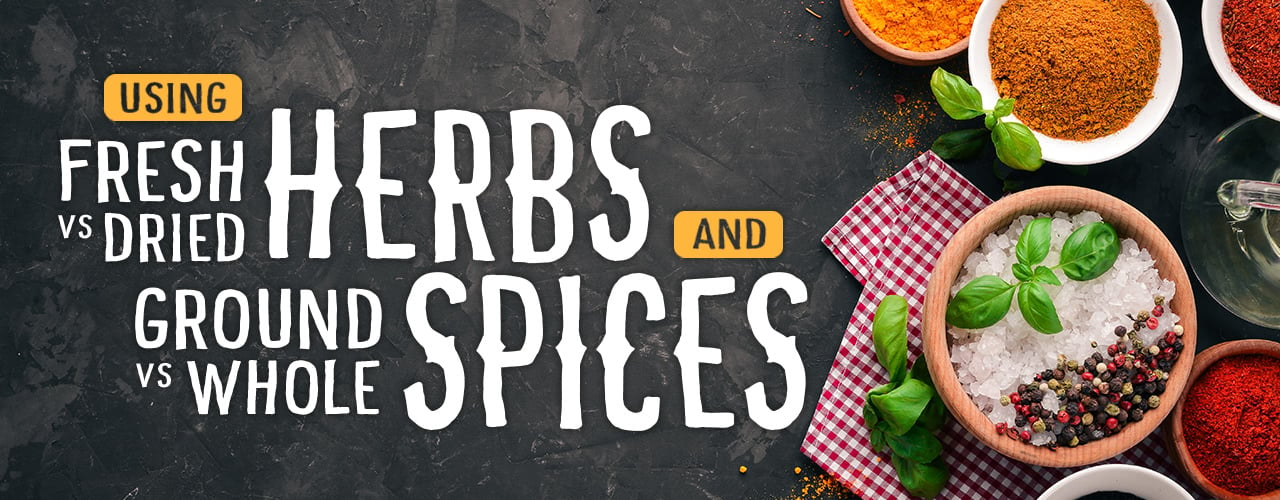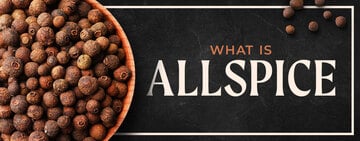Fresh to Dried Herb Conversion
Last updated on Nov 28, 2023Corrinn McCauleyIncorporating herbs and spices into your dishes enhances their flavor and helps you develop unique spins on time-tested recipes. To use herbs and spices optimally, you must know which herbs are better fresh vs dried. In a busy commercial kitchen, there will be times when you don't have the fresh or dried version of an herb on hand and must convert recipe quantities between the two. To ensure your recipe's quality, we provide conversions between fresh and dry herbs and whole and ground spices.
Shop All Herbs and SpicesFresh vs Dried Herbs

In general, dried herbs have more concentrated flavors than fresh herbs. Since you can use less of them and they don't truly expire, dried herbs are also a more economical choice. Examples of herbs that are better dried are oregano, thyme, marjoram, rosemary, fennel seed, curry leaf, and bay leaf.
However, soft, tender, and leafy herbs offer more flavor when fresh. Examples of the best herbs to use fresh are basil, parsley, chives, tarragon, and cilantro. If your staple recipes include these herbs, consider starting a culinary garden so you can ensure their freshness, quality, and availability while also cutting costs on purchasing fresh herbs.
While some herbs are more potent fresh vs dry, you can easily use the majority of herbs in both their fresh and dry forms. Both forms will still provide flavor and zest when added correctly to your dishes. Below is a table that shows which types of herbs are better fresh vs dried along with tips for using each.
| Fresh Herbs | Dried Herbs | |
| How to Use When Cooking |
|
|
| Type of Herb to Use | Use soft, tender, leafy herbs fresh | Use woody herbs dry |
| Common Examples | Basil, dill, cilantro, mint, parsley | Bay leaf, oregano, rosemary, thyme |
Fresh to Dry Herb Conversion
To convert a quantity of fresh herbs to the corresponding amount of dried flaky herbs, follow the below formula:
- 3-to-1 ratio of fresh to dry
- 1 tablespoon of fresh herb = 1 teaspoon of dried herb
Fresh to Ground Dried Herb Conversion

Flaky dried leafy herbs are more popular than finely ground herbs. When comparing dried oregano vs ground oregano, ground thyme vs dried thyme, or another type of herb, you'll find that the ground varieties have much stronger flavors than dried herb leaves, so you'll require less of them.
- 4-to-1 ratio fresh to ground dried or 1 tablespoon fresh = 3/4 teaspoon ground dried
- 6-to-1 ratio of dried leaf herb to ground dried herb or 1 tablespoon of dried leaf herb = 1/2 teaspoon of ground dried herb
Fresh to Dry to Ground Herb Conversions
The majority of herbs can be converted from fresh to dry using the 3-to-1 ratio and from fresh to ground using the 4-to-1 ratio. We provide conversions for the most popular herbs below.
| Herb | Fresh | Dried | Ground |
| Most herbs, including cilantro, dill, oregano, rosemary, and thyme | 1 tablespoon | 1 teaspoon | 3/4 teaspoon |
| Basil | 2 teaspoon | 1 teaspoon | 1/2 teaspoon |
| Bay leaf | 1 leaf | 1 leaf | 1/4 teaspoon |
| Parsley | 2 teaspoon | 1 teaspoon | 1/2 teaspoon |
| Sage | 2 teaspoon | 1 teaspoon | 1/2 teaspoon |
Back to Top
Herbs vs Spices

While both herbs and spices come from plants and are used to add flavor and aroma to food, they are not the same thing. Herbs come from the leaves of herbaceous plants and are used in both fresh and dried forms for savory cooking applications. Spices come from plants' roots, seeds, bark, or flowers. They are almost always dried and tend to offer stronger flavors than herbs.
Some plants offer both herbs and spices. The Coriandrum sativum plant's leaves are the cilantro herb, and the spice coriander is derived from its seeds. Dill seeds are used as a spice and dill weed, derived from the plant's stems and leaves, is a herb.
Ground Spices vs Whole Spices
Ground spices tend to lose their strength over time. On the other hand, you can grind whole spices right when you need them. Spices have their freshest and most robust taste right after they are ground, so purchasing whole spices can lead to more flavorful dishes.
Whole Spices to Ground Conversion

You will find most spices in powders, but a fair share can be stored in their whole form and ground at home. If a recipe calls for ground spices and you have whole spices on hand, follow our guide below to know how much whole spice you need to grind. Chefs cannot afford to estimate whole-to-ground spice conversions.
Exact measurements ensure the flavor quality and consistency of your meals. You wouldn't want a guest to return to your restaurant because they loved a particular dish only to have it taste different. Precise conversions also tell you how much of your whole spices you need to grind who each recipe, helping you conserve your supply so you can grind fresh spices for future culinary creations.
| Spice | Whole | Ground |
| Allspice | 1 teaspoon | 1 teaspoon |
| Black pepper | 1 teaspoon | 1 1/2 teaspoon |
| Cardamom | Approximately 12 pods, dehusked | 1 teaspoon |
| Cinnamon | 1 stick (1 1/2-inch) | 1 teaspoon |
| Cloves | 1 teaspoon | 3/4 teaspoon |
| Coriander | 1 teaspoon | 1 1/4 teaspoon |
| Cumin | 1 teaspoon | 1 1/4 teaspoon |
| Fennel | 1 teaspoon | 1 1/4 teaspoon |
| Ginger | 1 tablespoon fresh ginger | 1/4 - 1/2 teaspoon |
| Nutmeg | 1/2 nutmeg | 1 teaspoon |
| Mustard seeds | 1 teaspoon | 1 1/2 teaspoon |
| Turmeric | 1 tablespoon fresh turmeric | 1 teaspoon |
Back to Top
Nature helps you get creative in the kitchen. Consider the fresh taste of basil on a Caprese salad, the woodsy, savory flavor of rosemary chicken, or the earthy touch of sage in a creamy pumpkin soup. These dishes wouldn't be complete or as flavorful without the help of herbs and spices. Alternatively, mixologists can make their own bar ingredients with herbs and spices and create one-of-a-kind cocktails. Wherever you're using them, save our herbs and spices conversion calculator so you can reference back to it as you create new and exciting recipes.



